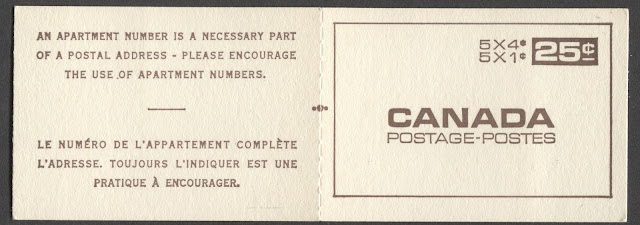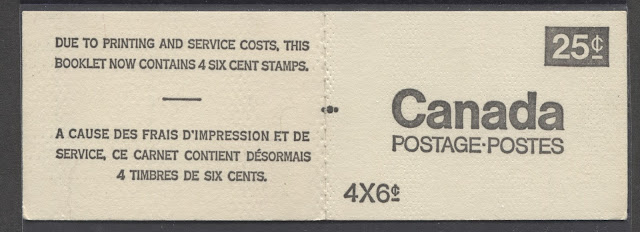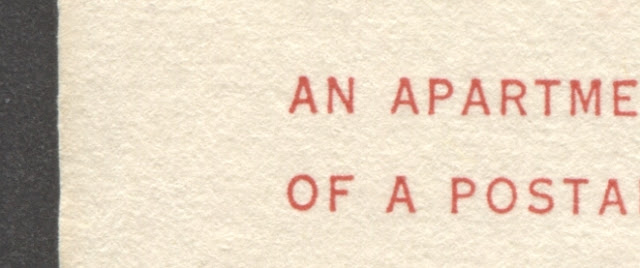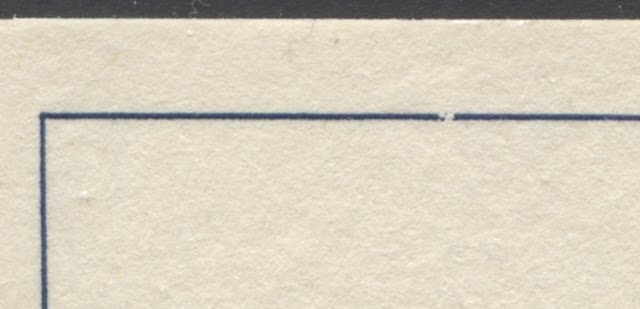Today, I start to examine the integral booklets that were produced for this issue. They are called "integral" because the booklet covers were a single piece of card stock, which was folded, and the booklet panes were glued onto the cover using the tab of the pane, rather than being either stapled or stitched. They were also significant as they were the very first time that se-tenant combinations of different designs and denominations were to appear in the same booklet pane. The printing technology required to accomplish this was in the hands of the British American Bank Note Company (BABNC) rather than the CBN. So the introduction of these booklets marks a unique period in Canadian stamp production in which two different printing firms collaborated to produce a Canadian stamp issue. Prior to this, every issue of Canadian stamps was printed by one firm or another, but never two firms at the same time. These booklets are also interesting in the sense that they are the first booklets to feature panes that are comb perforated, rather than line perforated, and also the first to include panes printed with PVA, rather than dextrine gum.
One significant fact has been brought to my attention by Mr. Eirwyn Jones, a specialist from the UK. He sent me an article from the February 1970 edition of Maple Leaves, which contains some interesting comments about how the booklets were actually produced. Apparently, the integral booklets were produced using continuous rolls of stamps and rolls of covers. The selvage tabs were moistened and attached to the cover stock in pre-determined positions, and the card stock was scored to facilitate folding (rouletted actually). A cross cutter, guided by an electric eye, would cut the booklets apart as they were printed, and then the were folded. This stands in sharp contrast to the method used for producing stapled booklets, in which the cover material and stamps were printed in sheets, which were assembled, stapled and then cut apart. This new method of production provides some explanation as to why there are never any cutting guidelines on either the booklet panes, or the covers.
It should be mentioned that the CBN did eventually acquire this technology too and used it to produce a single integral booklet: the OPAL booklet, which was issued in October 1970.
As I explained in last week's post, there is a large amount of scope to cover with these booklets, as the total number of basic integral booklets issued during the life of this issue was 16. I have decided to break it down into three parts:
The ribbed card stock. Look toward the top of the booklet cover to see the fine horizontal striations running across the cover. The third type of card stock with the rough surface looks identical to this except for the ribbing.
The fine print is shown on the left, and the bolder, coarser print is shown on the right in this side-by-side scan of two booklets.
One significant fact has been brought to my attention by Mr. Eirwyn Jones, a specialist from the UK. He sent me an article from the February 1970 edition of Maple Leaves, which contains some interesting comments about how the booklets were actually produced. Apparently, the integral booklets were produced using continuous rolls of stamps and rolls of covers. The selvage tabs were moistened and attached to the cover stock in pre-determined positions, and the card stock was scored to facilitate folding (rouletted actually). A cross cutter, guided by an electric eye, would cut the booklets apart as they were printed, and then the were folded. This stands in sharp contrast to the method used for producing stapled booklets, in which the cover material and stamps were printed in sheets, which were assembled, stapled and then cut apart. This new method of production provides some explanation as to why there are never any cutting guidelines on either the booklet panes, or the covers.
It should be mentioned that the CBN did eventually acquire this technology too and used it to produce a single integral booklet: the OPAL booklet, which was issued in October 1970.
As I explained in last week's post, there is a large amount of scope to cover with these booklets, as the total number of basic integral booklets issued during the life of this issue was 16. I have decided to break it down into three parts:
- The perf. 10 integral booklets which were printed by the BABNC and issued between January 1968 and May 1970.
- The perf. 12.5 x 12 integral booklets which were printed by the BABNC and issued between December 1970 and August 1971, as well as the OPAL booklet.
- The booklets containing the 8c parliament, which were issued between December 1971 and August 1972, due to their immense complexity.
This week's post will cover the first of these: the integral booklets containing the perf. 10 panes. McCann, in his catalogue insists that the perforation is actually 9.9, which is probably correct, although difficult to verify as my Instanta gauge is difficult to use reliably for measurements below about 10-10.5.
There were a total of 7 booklets issued that contained panes that were perforated 10. Three of these sold for 25c, two for $1 and two for $1.50. It thus makes logical sense to discuss them according to their overall denomination, and then to get into the details for each booklet. Many of the specific facts for numbers issued are taken from the McCann booklet catalogue, as well as some information about the collectible varieties.
In addition to the paper fluorescence varieties that can be collected for the panes themselves, there are differences in the fluorescence of the covers as well as differences in the appearance of the letterings that were stamped onto the cover stock. This is an area that I do not believe has received much, if any serious attention, though I wound bet that such attention would turn up worthy varieties for most, if not all of these booklets. There are also a handful of constant plate varieties which can be collected for most of these booklets.
The covers of these booklets were printed with a large rectangular counting mark on every 50th cover.
The 25c Booklets
The 4c + 1c Booklet of 10
These three booklets replaced the stapled booklets which had been issued in 1967. The first of these was issued in September 1968, and contained a pane of 10 stamps consisting of 5 1c stamps and 5 4c stamps. This was rather clever, because by issuing it this way, the user had 4c stamps for the local letter rate, and could always add a 1c stamp to make up the forwarded rate of 5c. A total of 1,464,000 booklets were issued. One drawback though was that one could wind up using all the 4c stamps and be left with a partial booklet of 1c stamps, which by themselves would be of little use. An example of this booklet and the contents is shown below:
The front and back covers, which are perforated in the middle and folded down the perforations. Note the three dot marking in the centre of the spine that extends onto both the front and back cover. This is NOT a counting mark, though many who are unfamilar with these booklets can make the mistake of thinking that this is a counting mark.
Here is the full pane of 10 with the 1c stamps on the left, and the 4c stamps on the right. As far as I know, no cutting errors have as yet been discovered where the 1c stamps are on the right. But in theory they could exist. The inside of the cover has a was coating to prevent the gummed side of the pane from sticking to the cover. Note the small rectangular marks at the top of the booklet in the tab. These cutting guidelines should be found on all booklets.
These panes are found on dead paper that is generally either a deep violet, or deep brown under UV light. They are also found on dull paper, and on dull paper with low and medium fluorescent fibres. They can be found with a guide-line between the top two stamps on the left side (1/1 and 2/1), and with a round corner on the second stamp from the top on the left side (2/1). Of course, both these varieties can be found on all of the three main types of paper on which these booklets are found.
The back covers show both fine lettering and coarser lettering. As we shall see, these differences are found on all of these booklets, which suggests that the finer print is from the earlier printings before the type wore and that the coarser print is from the later printings.
The 6c + 1c Booklet
In October 1968, the second of these booklets was issued and corresponded with the postage rate increase for the forwarded rate from 5c to 6c and the elimination of the local rate. It contained a pane of 5 stamps plus label. The pane included 4 of the 6c orange and 1 of the 1c brown, arranged in a 2 x 3 format, with the very first "stamp" being a printed label. The slogan on the label was always the same - a bilingual "Avoid Loss Use Postal Money Orders". A total of 21,604,000 booklets were issued. The 1c was clearly only included here in order to make the total face value of the pane equal to 25c. In reality there would have been many people walking around holding booklets that were empty except for a single 1c stamp, which seems kind of silly. An example of this booklet is shown below:
The front cover, showing the unboxed design that was introduced with this booklet.
The actual pane and inside covers of this booklet. Note the brown cutting guidelines at the top. Again, the inside of the cover was was coated. No cutting errors have as yet been reported, so the label is always on the left side. Several shades of the 6c orange can be found from a dull reddish orange to a bright orange, and this pane can be found printed in the fluorescent orange ink and fluorescent red ink.
This booklet is a favourite of many Centennial specialists, due to the fact that a number of varieties are possible with it. For starters, the panes can be found printed on dead paper, dull paper, low fluorescent paper with fluorescent fibres, and hibrite paper. The pane can be found with whole or partial numbers printed on the tab, and it can also be found ribber stamped "Cancelled" on a part pane. Of course, all of these tab varieties and ink varieties can be found on any of the four main papers listed, making for a large number of collectible booklets.
This is not listed or discussed in any of the catalogues that I have seen, but there are variations in the card stock used for the covers and there are variations in the appearance of the lettering. In terms of the card stock, while all of the covers I have seen are dull fluorescent and generally a greyish colour under UV, there are slight differences in the texture ans appearance of the card stock itself. I have come across three different types of card stock:
- A cream coloured stock, which shows very fine horizontal striations across the cover, that resembles ribbing.
- A smooth cream coloured stock that shows fine vertical dimples throughout the stock.
- A rough textured cream coloured stock that shows no ribbing.
Examples of each type of card stock are shown in the scans below:
The ribbed card stock. Look toward the top of the booklet cover to see the fine horizontal striations running across the cover. The third type of card stock with the rough surface looks identical to this except for the ribbing.
The smooth, dimpled stock. Notice that the surface texture is smooth, but punctuated by fine dimples that fall into a vertical pattern.
Looking back at the first 25c booklet, consisting of the 4c+1c, all the overs that I looked at were of the first type. This suggests that the card stock was changed part way into the production of these booklets, and that the ribbed stock gave way to the rough stock with no ribbing, and then finally to the dimpled stock.
Like the other booklets, this booklet also exists with the coarsely and finely printed covers:
The fine print appears and the top and the coarser print on the bottom.
Finally, various plate flaws can be found on these covers. Usually these consists of dots or blobs where there shouldn't be any. The example below shows a dot to the right of the "25c" box, on the front cover:
The 6c Booklet
Perhaps due to the redundancy of the 1c stamp that was included in the last booklet, it was decided, when the 6c black was issued, to dispense with the pane of 5 plus label, and to simply produce a pane of 4, 6c stamps and sell the booklet for 25c. This was the first time since 1955 that a booklet sold at a slight premium over the face value of the stamps contained in it. This booklet contained 4 stamps printed in the die 2, and was issued in May 1970. A total of 15,840,000 booklets were issued.
The cover and contents of this booklet are shown below:
The front cover. Note that the style of the letters is slightly different, and there is no "4x6c" on the cover, but just a single "25c" value panel.
The inside pane of 4. Like the other booklets, the inside covers are wax coated. Note the rectangular cutting guidelines at the top of the tab. So far, these panes are only known printed on dull paper that appears greyish under UV, with very fine vertical ribbing. This booklet does exist with partial numbers on the tab, and these are very scarce.
The $1 Booklets
The 4c Booklet
These two booklets were issued to replace the cello-paqs, which had been an issue format that had been in use since 1961. Thus, the post office department had no way of knowing how these booklets would be received by the public. The first of these, issued in January 1968, contained a pane of 25, 4c stamps. The pane was actually laid out in a 3 x 9 format, with the first two "stamps" being labels with printed slogans. The slogans are always the same, and are bilingual, with English on top:
- Moving? Ask for free change of address cards?
- Avoid loss - use postal money orders.
A total of 645,000 booklets were issued, which is very low compared to the other booklets, and may reflect the fact that the post office department did not know how these booklets would be received. These booklets were very handy for customers who only wanted to send local letters or postcards, but would not be of much use to those wanting to mail forwarded letters, as they would have to have had a supply of 1c stamps handy to make up the 5c rate. An example of this booklet, and the pane inside it is shown below:
The front and back cover, showing the same boxed design as the first 25c booklet. As best I can determine, all of the covers that I have seen on this booklet are printed on the ribbed card stock.
The pane of 25 stamps plus tab. Note how there are no markings on the tab and the labels are always on the left. The panes can be found on dead paper as well as on dead or dull paper with a sparse concentration of fluorescent fibres visible in the paper.
In addition to the paper varieties on the panes, the covers can be found both with the fine print and coarse print, as with the other booklets. There is also a cover type in which a dot appears above the word "An". These varieties are shown below:
The fine print is shown on the left, and the bolder, coarser print is shown on the right in this side-by-side scan of two booklets.
No dot above "An"
Dot above "An"
The 5c Booklet
In August of 1968, a booklet containing 20 of the 5c was issued to allow those wanting to mail a quantity of forwarded letters, an ample supply of stamps. The pane of 20 was printed in a long 2 x 10 format. Thus a person could buy one of each booklet and have all the stamps they needed to send 20 local letters or postcards, and 20 forwarded letters, without having any leftover stamps. A total of 1,724,000 booklets were issued. An example of that booklet, and the pane inside is shown below:
The front and back cover showing the boxed design that was in use until late 1968. All of the covers that I have examined are printed on the ribbed stock.
The pane of 20 stamps. Again, note how there are no markings on the tab.
The panes can be found on dead paper, dull paper and dull paper with low fluorescent fibres. In addition, booklets can be found with partial numbers on the tab. There are two constant varieties that can be found on the panes of this booklet. One is the broken necklace, which I have discussed in an earlier post, and which generally occurs on the second stamp in the top row. Sometimes I have found it on other stamps as well. The other variety is the "extended line from the lobster trap". This is a very common ink drag flaw that occurs on some booklets. I do not currently have an example of this variety that I can show here, but will add one when I can. The broken necklace is shown again below:
The normal, complete necklace is shown on the left, while the broken necklace appears on the right.
All of these varieties in theory, including the numbers on tab could be found with all three paper types, although McCann only lists the panes with numbers on tab as occurring with the three paper types and not with either plate variety.
The covers exist in a variety of different shades of blue, as well as with the coarse and fine print. Finally, covers can be found with breaks in the boxed frame. Examples of all these varieties are shown below:
Dark blue and paler blue, due to under-inking.
Coarse print on the left and finer print on the right.
Frame break at the top left.
The $1.50 Booklets
These booklets were produced to replace the $1 booklets when the postage rates increased from 5c to 6c for all domestic destinations. The booklet format of 25 had proven popular with the public and somehow $1.50 for a booklet seemed like a better price point than $1.20 for a pane of 20, not to mention that it would be easier to account for in the P.O. records. These panes were thus printed in panes of 27, for which the first two stamps were actually labels with slogans. The slogans were the same bilingual ones used on the 4c booklet, except that they appear in the opposite order. The panes were the same 3 x 9 format as had been used on the $1 booklet containing 25, 4 cent stamps. The first of these was issued in December 1968 and contained 25 of the 6c orange. The second was issued in January 1970, and contained 25 of the 6c black die 1.
An example of the 6c orange booklet is shown below:
The front and back covers showing the new unboxed design. Note the large rectangular counting mark across the spine. This is what the counting mark on these booklets should look like. It needn't be found in this exact location - it can be found anywhere along the spine of the affected booklet. All the covers that I have seen for this booklet are on either the ribbed stock, or the rough, unribbed stock. I have only seen the coarser print on this booklet so far, but I think the fine print must exist as well.
The pane of 25. These panes can be found on dead paper, dead paper with low fluorescent fibres, on low fluorescent paper with fluorescent fibres, and finally on high fluorescent paper. The second stamp from the bottom on the left side (9/1) can be found with a mole on the lip or nose. A total of 2,660,000 booklets were issued.
An example of the 6c black booklet is shown below:
The front and back cover. All of the covers I have seen on this booklet are either the rough unribbed stock, or they are the dimpled stock. I have only seen the coarser print on this booklet so far, but I think the fine print must exist as well.
The pane of 25. A total of 4,070,000 booklets were issued. These panes can be found on four different types of paper: dull paper, low fluorescent paper, low fluorescent paper with fluorescent fibres, medium fluorescent paper and hibrite paper. In addition, these panes can be found with vertical scratches across the sixth row of stamps. These exist in up to 12 different patterns of vertical strokes, which have been identified by the Centennial study group, but are to difficult to describe here. I do not have any examples to illustrate here, but I will add images of them as I acquire them.
These booklets contain two of the rarest and most sought after varieties in this issue:
- The cutting error on the orange booklet in which the two labels are separated by a stamp, instead of being located adjacent to one another on the left side of the pane. This variety lists in Unitrade for $5,000.
- The hibrite paper on the 6c black pane, which lists in Unitrade for $4,500.
This concludes my discussion of the perf. 10 vertical booklets. Next week, I will examine the OPAL booklet printed by CBN and the perf. 12.5 x 12 booklets, except for those containing the 8c.



























